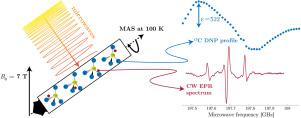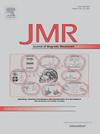7 T低温魔角旋转连续波EPR和DNP光谱学
IF 1.9
3区 化学
Q3 BIOCHEMICAL RESEARCH METHODS
引用次数: 0
摘要
动态核极化(DNP)依赖于微波辐照下电子极化向原子核的转移,通常在高磁场下低温魔角旋转(MAS)下进行。回旋管是DNP中常用的微波源,因为它们能够在宽频率范围内产生高功率微波。深入了解DNP机制和合理优化DNP性能的重要一步是使用仪器,它可以提供有关DNP过程的信息。连续波(CW)电子顺磁共振(EPR)可以在DNP实验中揭示电子自旋系统的重要信息。在这里,我们提出了一个双连续波EPR/DNP光谱仪,在100 K和7 T的MAS下工作,使用频率灵活的198 GHz回旋管。使用MAS定子测量的198 GHz连续波EPR灵敏度为4 × 1013个自旋/(GHz)。为了说明我们的装置的电子和核探测能力,在相同的条件下,特别是在100 K和MAS下,记录了金刚石粉末和三烷基样品的DNP谱和连续波EPR谱。本文章由计算机程序翻译,如有差异,请以英文原文为准。

Cryogenic magic-angle spinning continuous wave EPR and DNP spectroscopy at 7 T with a gyrotron
Dynamic nuclear polarization (DNP) relies on the transfer of electron polarization to nuclei through microwave irradiation and is typically performed under cryogenic magic-angle spinning (MAS) at high magnetic fields. Gyrotrons are commonly used microwave sources in DNP because of their ability to produce high-power microwaves over a broad frequency range. An important step towards a more in-depth understanding of DNP mechanisms and rational optimization of DNP performance is the access to instrumentation, which can provide information about the DNP process. Continuous wave (CW) electron paramagnetic resonance (EPR) can reveal important information on the electron spin system during DNP experiments. Here, we present a dual CW EPR/DNP spectrometer operated under MAS at 100 K and 7 T using a frequency-agile 198 GHz gyrotron. The measured sensitivity for CW EPR at 198 GHz using an MAS stator is 4 1013 spins/(G). To illustrate the electron and nuclear detection capabilities of our setup, DNP profiles and CW EPR spectra of a diamond powder and a trityl sample were recorded under the same conditions, specifically at 100 K and under MAS.
求助全文
通过发布文献求助,成功后即可免费获取论文全文。
去求助
来源期刊
CiteScore
3.80
自引率
13.60%
发文量
150
审稿时长
69 days
期刊介绍:
The Journal of Magnetic Resonance presents original technical and scientific papers in all aspects of magnetic resonance, including nuclear magnetic resonance spectroscopy (NMR) of solids and liquids, electron spin/paramagnetic resonance (EPR), in vivo magnetic resonance imaging (MRI) and spectroscopy (MRS), nuclear quadrupole resonance (NQR) and magnetic resonance phenomena at nearly zero fields or in combination with optics. The Journal''s main aims include deepening the physical principles underlying all these spectroscopies, publishing significant theoretical and experimental results leading to spectral and spatial progress in these areas, and opening new MR-based applications in chemistry, biology and medicine. The Journal also seeks descriptions of novel apparatuses, new experimental protocols, and new procedures of data analysis and interpretation - including computational and quantum-mechanical methods - capable of advancing MR spectroscopy and imaging.

 求助内容:
求助内容: 应助结果提醒方式:
应助结果提醒方式:


